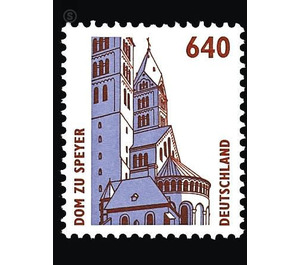Postage stamps: Places of interest - Germany / Federal Republic of Germany 1995 - 640 Pfennig
Theme: Architecture
| Country | Germany / Federal Republic of Germany |
| Issue Date | 1995 |
| Face Value | 640.00 |
| Color | brown white |
| Perforation | K 14 |
| Printing Type | indirect 2-color letterpress |
| Stamp Type | Postage stamp |
| Item Type | Stamp |
| Chronological Issue Number | 1684 |
| Chronological Chapter | GER-BRD |
| SID | 343492 |
| In 31 Wishlists | |
The multi-towered city of Speyer, dominated by its Romanesque cathedral, is emblazoned prominently in the foothills of the Rhine, dominated by its Romanesque cathedral, the "Imperial Cathedral" and burial place of the Salier, and the largest surviving Romanesque building in Germany, which has been a World Heritage Site since 1980. The unusually large sandstone square building over the plan of the Latin cross was begun around 1025 under Conrad II and by his successor Henry III. almost completed and consecrated in 1061. This first building (Speyer I), with a total length of 133 meters, still showed a flat-roofed central nave, while aisles and choir were arched. Under Henry IV., The church after 1080 to the early 12th Century thoroughly transformed, vaulted the nave and added a number of chapels (Speyer II). The destruction of the Palatinate by French troops in 1689 left the cathedral as a ruin. For nearly a century, its use was limited to the provisionally prepared eastern part. It was not until 1772-78 that the western building was reconstructed to plans by Franz J. Neumann. Hardly finished, the building was devastated again in 1794 by French troops and profaned, the diocese of Speyer 1801-17 repealed. Once again, the building was re-consecrated in 1822. The fifties of the 19th century brought forth the present form of the church. The imperial graves were opened in 1900-1906 and made accessible. Among them is the grave of the founder Konrad II, his wife Gisela, Emperor Henry III, IV and V and King Rudolph of Habsburg. (Text: State Office for the Preservation of Monuments, Mainz)


